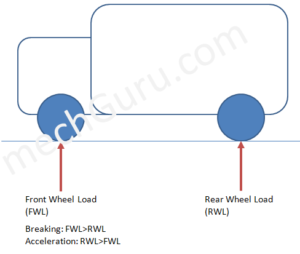Brake system of an automobile, as you already know how it works, stops the wheel from rotating further.
But in conventional hydraulic braking system, at all the wheels equal amount of hydraulic brake fluid pressure get transmitted as a result, at all the wheels equal amount of braking force get developed irrespective of loading, acceleration and deceleration condition of the vehicle.
Why equal braking force at all the wheels always is not good?

Because, each wheels doesn’t carry equal load or vehicle weight all the times.
When, the vehicle gets accelerated, more loads are transferred at the rear wheels.
And, while breaking or declaration weight will be transferred to the front wheels.
As all the wheels are not carrying equal load all the times, so if equal braking load is applied at all the wheels then at some of the wheels more than required braking force will be applied, means some of the wheels will stop rotating or locked before other wheels. This is a dangerous situation as the driver will tend to lose control of the vehicle as vehicle will skid uncontrollably.
Bottom line is, to have better control for the driver while breaking, it is necessary that all the wheels get breaking force according to the dynamic load on that wheel.
There are many breaking technologies evolved to achieve the better automobile vehicle control while breaking:
1. Load Conscious Regulating Valve (LCRV) or Load Sensing Proportioning Valve (LSPV)
2. Deceleration Conscious Regulating Valve (DCRV) or G valve
3. Pressure Conscious Regulating Valve (PCRV)
4. Anti Lock Breaking System (ABS) and Electronic Stability Program / Control (ESP /ESC)
Working of LCRV or LSPV system

Worked on the principle that amount of load acting on the rear axle is inversely proportional to the distance between the body (or loadbody in case of trucks) and the rear axle.
In case of breaking, while transferring dynamic load from the rear axle to the front wheels, the distance between the rear axle and the body increases and lesser breaking pressure will be applied to the rear wheels, as a result the vehicle will have better stability while breaking.
If you would like to compare all the four technologies in term of cost and effectivity, then:
According to costs / effectiveness: ABS/ESP/ESC > LCRV/LSPV > PCRV >DCRV
Hi, I am Shibashis, a blogger by passion and an engineer by profession. I have written most of the articles for mechGuru.com. For more than a decades i am closely associated with the engineering design/manufacturing simulation technologies. I am a self taught code hobbyist, presently in love with Python (Open CV / ML / Data Science /AWS -3000+ lines, 400+ hrs. )
